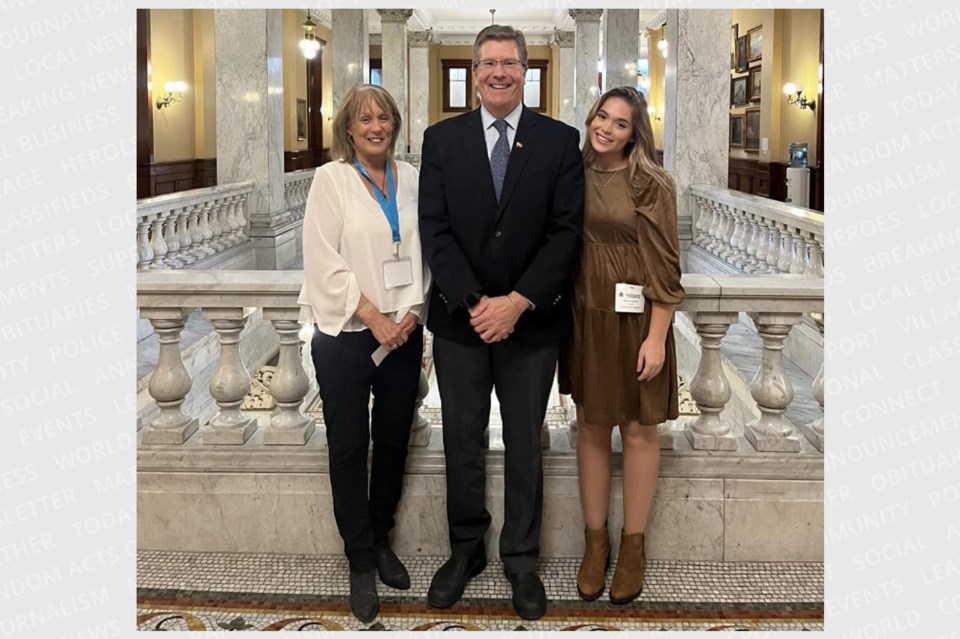BradfordToday welcomes letters to the editor at [email protected] or via our website. Please include your daytime phone number and address (for verification of authorship, not publication).
Today is Worldwide Cystic Fibrosis Day.
Cystic fibrosis is a genetic disease that damages the lungs, the digestive tract, and many other organs due to excess mucus and chronic infection.
My daughter, Madi, lives with cystic fibrosis. After many months of repeated illness, she was finally diagnosed at eight months old. It was a very tough pill to swallow. At the time, the median for patients living with cystic fibrosis was 14.6 years. A diagnosis generally meant a lifetime spent fighting a disease that promised to never give up. Despite hours doing physiotherapy to clear the lungs, taking handfuls of pills to help properly absorb fats and proteins, and repeated hospital admissions to battle chronic infections, this disease continued to shorten lives. Many could have a few years added by having a lung transplant. That would be if they were healthy enough and hung on long enough for an organ match to be found. The prognosis was not good. After we digested what we were up against, we committed to keeping Madi as healthy as we could while doing all we could to find a cure.
Cystic fibrosis hit Madi particularly hard. She struggled to gain weight and suffered chronic sinus infections, headaches, digestive issues, and frequent lung infections. Madi generally spent more than a month of every year admitted at the Hospital for Sick Children. I might add that we were very fortunate to have one of the best cystic fibrosis clinics in North America. The team was like family. Despite this amazing care, Madi’s quality of life was very poor, to say the least. We held fundraisers to fund research, and Madi participated in trial after trial in an effort to gain valuable insight into how this disease could be better controlled.
She was 10 when, during one of these trials, things took a turn for the better. Madi carries a very rare gene mutation for CF and there was a new gene modulator that could actually repair the defective gene causing all the issues. It was a blind study. However, we knew within two days that Madi was on the real drug. She told me she could breathe through her nose for the first time. Within 30 days, she had gained weight, had her headaches and sinus issues resolved and, best of all, her lung function increased from 78 to 115 per cent of expected value. It was incredible. The celebration didn’t last long as we quickly realized that the drug was not covered by our insurance and was not available on the public formulary. In fact, it hadn’t even had pricing negotiated so that a decision could be made to add it to the formulary.
With the support of the community, Madi and I began a campaign to have the drug negotiated and added to the public formulary. It took nearly two years — too long, in my opinion, as patients lost their battle against the disease while we worked to hasten the bureaucratic process.
Kalydeco was finally added to the public plan for patients who fit the criteria in 2012. As this drug was only for three to four per cent of the CF population, the manufacturer worked to find a drug that would benefit more of the population. A couple of modulators came after Kalydeco, but as they didn’t show the same effectiveness, access was very limited.
In 2019, Trikafta, a modulator that would benefit 90 per cent of the CF population, was made available in the United States. Trikafta has been a game changer for CF patients around the world. Once again, we were back in battle mode. As this drug was going to help many more patients than Kalydeco, there were many more voices in this fight. Once again, it took longer than it should have and, once again, due to the process, young lives were lost, but eventually, the drug was added to public formularies across Canada. We have seen people come out of hospital beds and off transplant lists and head back to the workforce. The modulators are not a cure but have certainly put life back into the lives of patients living with this disease.
While we celebrate how far we have come, we also take time to recognize how far we need to go. There is the 10 per cent of patients that still do not have a modulator that will benefit them. There are also a lot of issues involving access to current modulators, such as a young woman in Ottawa whose CF specialist believes she would benefit from Trikafta, but she does not have access due to restrictive criteria. This young woman has only 30 per cent lung function. Every breath is a struggle, even with oxygen.
This is why Madi and I continue to work alongside our CF community and the rare disease community to try to remove barriers to patients who need innovative medications to live. We are hoping that the rare disease drug strategy announced in March will help address these issues so that Canadians living with chronic rare diseases will have access to treatments and therapies. To take a bigger step outside our bubble, we recognize the many patients and families living in low- and middle-income countries who are without many of the lifesaving treatments and therapies for cystic fibrosis.
So, as we recognize Worldwide Cystic Fibrosis Day, we will celebrate how far we have come, and focus on the work that lies before us to ensure no one is left behind.
Beth Vanstone
Bradford



